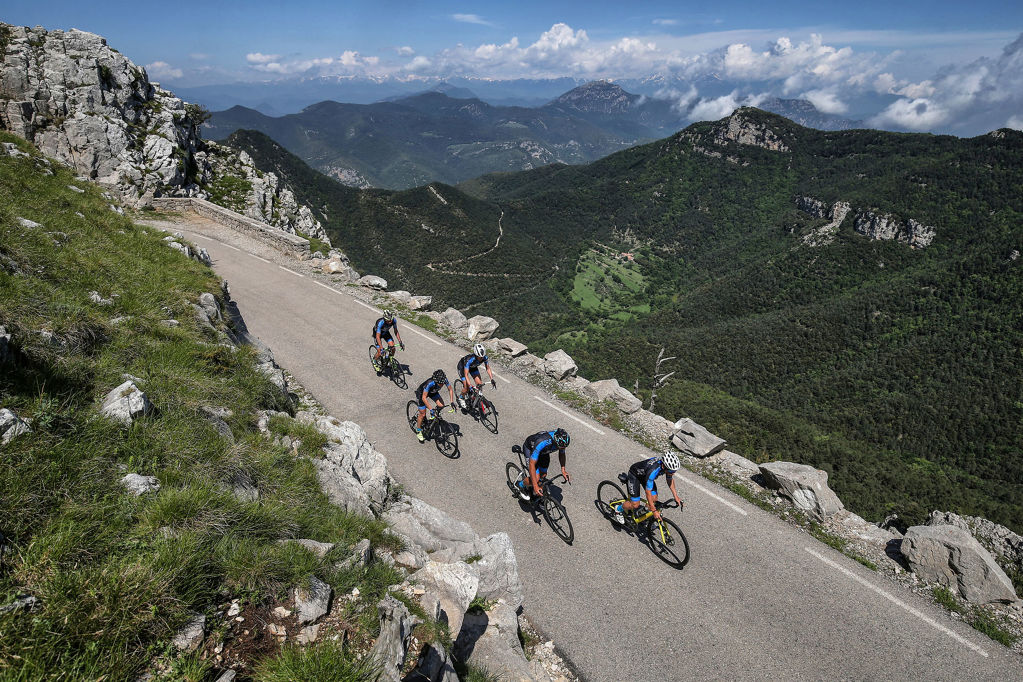
Banyoles - Mare De Déu Del Mont - Rocacorba - Banyoles
Banyoles - Mare De Déu Del Mont - Rocacorba - Banyoles
Transfer needed 45'
 Distance:
100 km
Distance:
100 km
 Elevation gain:
1.900 m
Elevation gain:
1.900 m
 Max. Elevation:
1.070 m
Max. Elevation:
1.070 m
Water points
- Banyoles
- Esponellà
- Crespià
- Cafeteria-restaurant of the Sanctuary of Mare de Déu del Mont
- Rocacorba Food Truck (only weekends and public holidays)

|
MOUNTAIN PASSES |
CATEGORY |
DISTANCE |
ELEV. CHANGE |
AVERAGE % |
MAX. GRADE |
||
|
Mare de Déu del Mont |
1a |
18 km |
11,19 mi |
940 m |
3.083,99 ft |
5,2% |
17% |
|
Rocacorba |
1a |
13,3 km |
9 mi |
800 m |
2.624,67 ft |
6% |
15% |
|
SECTIONS WITH TRAFFIC DENSITY / ROAD SURFACE DEFECTS |
HIGH DENSITY |
MEDIUM DENSITY |
LOW DENSITY |
|
GIP-5121 |

Straight section with wide hard shoulder |
||
|
Climb to Mare de Déu del Mont |

Secondary road |
||
|
GIP-5121 |

Straight section with wide hard shoulder |
||
|
Banyoles |

Urban stretch |
||
|
Climb to Rocacorba |

Secondary road |
Our departure point is just outside the building of the Banyoles Swimming Club, from where we head towards Esponellà along the GIP-5121 road. This is a road with little traffic and elevation gain but with long straight stretches, making it ideal for warming up and high-speed cycling.
We pass through Crespià and soon reach the N-260 road from Figueres to Besalú: we cross it carefully in order to take the GIP-5237 road that will lead us to Sant Martí Sasserres. We leave the little village on our right and begin the long, hard climb up to the Sanctuary of Mare de Déu del Mont.
We ride past Falgars and Sant Llorenç de Sous along the thousand bends of this narrow but fantastic road, gaining height little by little as we complete the tough kilometres of the climb.
As we gain height, the view of the surrounding landscape opens up to reveal the county of Pla de l’Estany, along with much of the Pyrenees.
The last few kilometres of the climb are extraordinary as we ride past rock needles that appear to be guarding the sanctuary.
At the top we can enjoy the breathtaking panoramic view of the stunning landscape. The sanctuary has a restaurant if we need to replenish our energy levels.
We then go back on ourselves to Banyoles.
Once we get back to the Banyoles Swimming Club, if we still haven’t had enough we can take on another major climb: Rocacorba. The climb begins more or less at the lake itself along the GIV-6247 road.
Rocacorba is a classic climb that’s very popular with local and visiting cyclists alike; so popular, in fact, that a food truck now serves breakfasts and snacks on the esplanade just below the summit.
We soon reach the first tough slopes. Passing through Pujarnol, we then come to the toughest bends of the climb. The going remains tough for the next few kilometres, with the occasional short descent, until we reach the summit of Rocacorba. There at the top there’s a wonderful vantage point from which to enjoy views of Banyoles Lake and the county.
Once we get our breath back, we can head back along the same route to the Banyoles Swimming Club, our departure point.
Points of interest
Banyoles Lake: the largest natural lake in Catalonia, fed by the subterranean aquifers from the north and west, in the Alta Garrotxa area. The richness of the landscape and the biodiversity of the lake are truly remarkable. It’s also a fantastic place for water sports such as rowing and open-water swimming, for which a special lane has been marked out. See the list of areas where open-water swimming is permitted.
Sanctuary of Mare de Déu del Mont: 14th-century sanctuary at the top of the mountain. It houses Our Lady of the Mount, a 14th-century Gothic polychrome alabaster carving. The sanctuary complex is composed of a hostel, a church and a cafeteria-restaurant with an extraordinary vantage point.
Sanctuary of Rocacorba: just a few metres below the summit, a small 13th-century sanctuary is tucked away that was built on the ruins of an even older mediaeval castle. The sanctuary is devoted to Our Lady of Rocacorba (also known as Our Lady of the Pear). A replica carving by the sculptor Ramon Casellas is housed in the sanctuary. The original carving is housed in the Girona Art Museum.